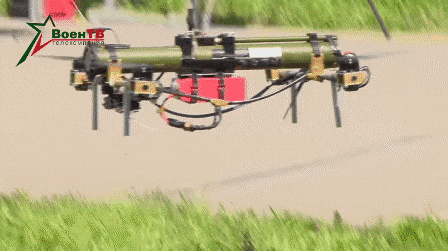Drone is an expansive category, a catch-all name that transcended its aerial target past and now universally covers any flying machine operating under human-controlled or human-directed flight, without any people on board. How far can we stretch this definition? What about an rocket launcher, with four rotors attached, remotely controlled from the ground. As absurd as it sounds, it is also real:

This drone was spotted by Defense Blog, which notes that the rocket launcher appears to be an old single-shot Soviet model, the RPG-26. In the video, the drone takes off and launches seconds afterwards, which is the likeliest scenario for a machine like this. Electric motors and battery power are enough to keep small, light, camera drones in the air for about half an hour, but any increase in payload weight really drags down the flight time. And, given that the weapon is single-shot, it’s unlikely that any future unit of infantry armed with a flying rpg launcher is going to want to use that machine for scouting. That’s a job for cheaper, simpler drones. Instead, should this be fielded, we can expect to see it pop up from behind cover to strike at armor from above without immediately jeopardizing the human doing the firing.
Putting an RPG on a drone (or, really, putting drone parts on and around an RPG) is a novel way to give people on foot cheap air support, but it’s hardly the only way. The confusingly named “Predator AX-1” is an RPG round in a single use drone body, meant to be fired by infantry at lightly armored targets, and it has a cousin in the Switchblade drones adopted by the U.S. Marine Corps. And between the two, there are drones like the Velvet Wasp that are designed to glide-launch RPG warheads from a normal octocopter body.
The overall trend, for anyone trying to guess at infantry armaments in the next five to ten years, is that air support will be a thing infantry can provide for itself. The low sky immediately above the heads of people doing the fighting is a contested space. And the armor on the tops of tanks, APCs, and other armored vehicles is again a weak point that can be exploited by a canny foe.
Should the infantry miss with the single-shot Belarusian RPD drone, there’s already an upgrade sitting next to it: a heftier quadcopter, this time with two RPS slung beneath its rotors.
Kelsey Atherton blogs about military technology for C4ISRNET, Fifth Domain, Defense News, and Military Times. He previously wrote for Popular Science, and also created, solicited, and edited content for a group blog on political science fiction and international security.








